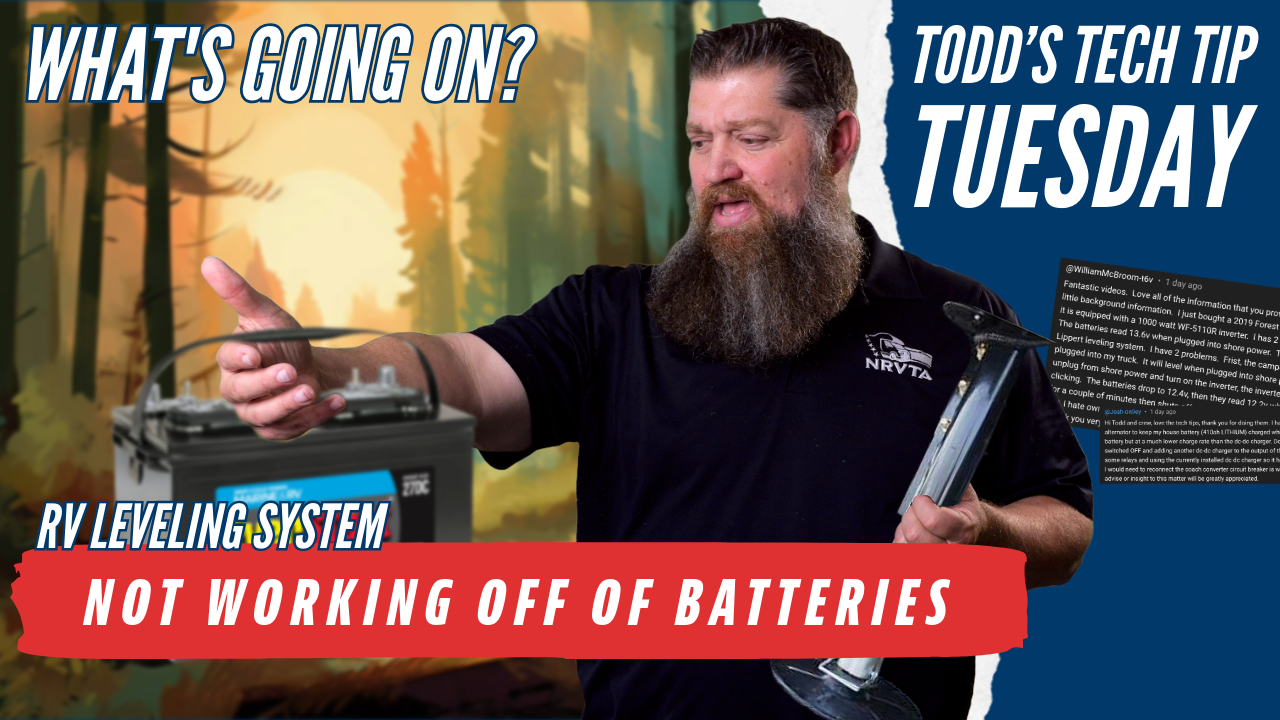Get your RV Technician Certification in as little as 5 weeks!

Welcome back to Todd’s Two-Minute Tech Tip Tuesday, brought to you by the National RV Training Academy, the largest hands-on RV training center in America. Whether you’re looking for expert advice to troubleshoot your RV or simply want to learn more about RV systems, you’re in the right place. Today, we’ll address two battery-related questions that highlight common issues RV owners face with power systems.
Question 1: Forest River Saber’s Power Problems
William McBroom recently bought a 2019 Forest River Saber with a residential fridge and a 1000-watt inverter. His setup includes two 80-amp-hour batteries, but he’s facing two main issues:
- The RV won’t self-level when running on batteries or connected to the truck.
- The self-leveling system only works when plugged into shore power or a generator.
- The inverter shuts off after running for about 5 to 10 minutes.
- The inverter clicks before shutting down, and the batteries drop from 12.6V at rest to 12.2V when this happens.
Diagnosis
The first issue is clear: the batteries can’t handle the heavy load of the self-leveling system or the inverter when they are running without shore power or generator support. Both the self-leveling system and inverter demand a lot of power, and it seems the batteries aren’t delivering enough.
- Batteries and Flow Issues: You have two 80-amp-hour batteries, which, on paper, seem sufficient, but in reality, they aren’t providing the needed current flow for high-load operations like leveling and inverter use. While your lights and fans may work fine on these batteries, heavy loads require significant current, and any weak point—like a loose connection—can prevent the necessary flow.
Potential Fixes
- Check for Loose Connections: A loose connection, especially on the positive side between the batteries and your components, can prevent the flow needed for high-demand systems. You should inspect both positive and negative connections, including where they attach to a bus bar or grounding frame.
- Inspect Battery Condition: Even if the batteries are charging, they may not be holding the charge as well as they should. Over time, batteries degrade, and even if they show a full charge, they may drop quickly under load. If these are the original 2019 batteries, they might need to be replaced.
- Test with a Voltmeter: You’re already watching voltage drops, which is great. Keep an eye on how far the voltage dips under load. A significant drop when turning on the inverter or self-leveling system could point to a weak battery or poor connection.
Question 2: DC to DC Charger and Generator Charging Rates
Josh has a DC-to-DC charger that uses his truck’s alternator to keep his lithium house batteries charged while the engine is running. He also noticed that the onboard generator charges the house battery at a much lower rate than the DC-to-DC charger. He wonders if he should turn off the coach converter and use the DC-to-DC charger for faster battery charging.
Diagnosis
Let’s break this down:
- DC-to-DC Charger Performance: Depending on the model, a DC-to-DC charger connected to your truck’s alternator typically pushes around 30 amps of power to your house batteries. However, this seems unlikely to outperform your RV’s onboard converter, which is probably rated for 45 amps or higher.
- Low Charging Rate from the Generator: The problem seems to lie with your RV’s converter. If the generator is providing AC power but the batteries aren’t charging as quickly, it could mean the converter is faulty or there’s a loose connection between the converter and batteries.
Potential Fixes
- Check the Converter’s Output: Use a voltmeter to measure the converter’s output when the generator is running. It should be around 13.6V. If it’s much lower, the converter might be failing, or there could be a loose connection.
- Inspect Automatic Transfer Switch (ATS): If you see differences in performance between shore power and the generator, the ATS may be malfunctioning. The ATS manages the switch between shore power and generator power, and if the contacts are worn or faulty on the generator side, it could reduce the efficiency of charging.
Avoid the DC-to-DC Charger Misstep
Josh also asked if adding a DC-to-DC charger to the generator output would speed up battery charging. However, this won’t work because the generator produces AC power, not the DC power needed for the DC-to-DC charger. Running AC through a DC device would cause major issues and could damage your system. Instead, the focus should be on fixing the converter.
Conclusion: Fixing Loose Connections and Faulty Batteries
In both cases, the issues point back to battery or connection problems. For William, it’s either a loose connection or failing batteries that can’t handle heavy loads. For Josh, the issue likely lies with the converter or automatic transfer switch, causing poor charging performance from the generator.
The key takeaway? Before replacing expensive parts, always check the basics: loose connections, battery condition, and converter output. By systematically troubleshooting these areas, you can avoid costly mistakes and get your RV systems back up and running efficiently.
If you’re facing similar issues or want to learn how to troubleshoot your RV like a pro, check out our RV tech courses at RVTechCourse.com. Happy RVing, and stay tuned for more tech tips!
Get Registered Today!
Talk to a student advisor to learn more!